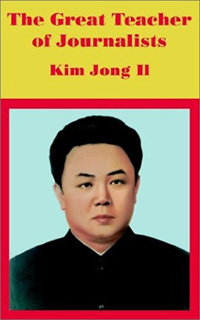
In 2001, Kim Jong-il began wooing the foreign media. But The Dear Leader had long since been pursuing his homeland press, offering counsel and copyediting. In 1983, Kim’s journalism teachings were compiled and published in English—by the DPRK’s Pyongyang-based Foreign Languages Publishing House—in a 170-page volume adorned with Kim’s unsmiling face and titled, The Great Teacher of Journalists.
Comrade Kim was “always among journalists,” boasts the book’s preface. He “place[d] the pressman at the zenith of happiness and glory” and could be found “constantly giving them meticulous guidance in spite of the heavy pressure of the task of leading the revolution and construction.” Indeed, the book confirms, “the annals of the care with which the dear leader . . . has guided and looked after the men of the press are replete with moving stories,” like when he made “perfect” someone else’s political essay with “his benevolent pen marks.” Or, that one time he “corrected” something in a reporter’s notebook. Or how, (and, this is a chapter title), “A Reporter [Was] Saved Miraculously from the Jaws of Death”—by Kim Jong-il.
Among The Great Teacher’s specific bits of advice:
For news photographers “In fixing the place of the camera, the cameraman’s first consideration should be how to take the leader’s best picture.” Also: “Press the shutter when you are sure of success.”
For broadcasters “Inanimate, inert and dull speech would be unable to rouse people vigorously to the revolutionary struggle. . . . Announcer’s voice itself must give an impulse to rush forward.”
On puff pieces “Giving prominence to these typical men is an effective method of imbuing people with loyalty to the Party and the leader.”
On reading up “Journalists must read books more than anyone else and make study their regular habit. In particular, you must profoundly study the leader’s works. . . . Only then will you be able to successfully carry out information activities in accordance with the leader’s thoughts and intentions.”
On shoe leather “Comrade journalist, you must see things on the spot before you write your articles. Otherwise you may talk big.”
Or, be swayed by big talkers.
Liz Cox Barrett is a writer at CJR.
